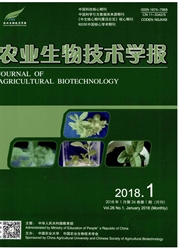

 中文摘要:
中文摘要:
利用PCR-Southem对菊科26个种和2个菊花(Dendranthema×grandiflora)栽培品种的甜菜碱醛脱氢酶(betainealdehydedehydrogenase,BADH)基因进行了检测,其中18个种和2个栽培品种呈现明显的阳性信号。对其中7个种和1个栽培品种的PCR产物进行了测序(GenBank登录号:EF683587~683595),其中旋覆花(Inulajaponica)中获得2个长度差异较大的序列。序列分析表明:在被克隆的基因片段中,外显子的长度在各种间是一致的,且同源性在83%以上,推测的氨基酸序列的同源性在90%以上,其中旋覆花长片段中保守十肽的第2个氨基酸由苏氨酸变异为丙氨酸。各序列内含子的长度差异较大,泽兰(Eupatoriumlindleyanum)、祁州漏芦(Stcrnmacanthauniflora)和旋覆花长片段的内含子之间,及与其它序列的内含子之间均无明显的同源性,而其它序列的内含子问则表现出较高的同源性,且由内含子所反映的基因间的系统关系与外显子反映的系统关系一致。
 英文摘要:
英文摘要:
Betaine aldehyde dehydrogenase (BADH) gene was tested in 26 species of Compositae and 2 chrysanthemum (Dendranthema × grandiflora) cultivars by PCR-Southern. Eighteen species and 2 cultivars showed clear positive signal. The PCR products of 7 species and 1 cultivar were sequenced (GenBank accession No. EF683587--683595 ). Two homologous fragments of BADH gene, which were very different in length, were obtained from Inula japonica. Sequence analysis showed that the cloned exon regions were identical to each other in length, the homology among them was above 83%, and the homology among the deduced amino acid sequence was above 90%. The second site was changed from threonine to alanine in the conserved decapeptide in the longer fragment from lnula japonica. The length of intron region was very different among the cloned sequences. There was not apparent homogology among the intron regions from Eupatorium lindleyanum, Stemmacantha uniflora and the intron region of the longer sequence from I. japonica. And there was not apparent homology between the 3 intron regions and any other intron regions. However, there was apparent homology among the other intron regions. And the dendrogram of gene relationships from the clonedintron sequences was identical to that from exon sequences.
 同期刊论文项目
同期刊论文项目
 同项目期刊论文
同项目期刊论文
 期刊信息
期刊信息
